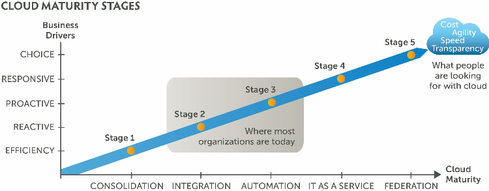As your organization barrels ahead into the world of cloud computing, you might wonder how ready your IT team is for such a change. How easily it adapts and thrives with cloud has as much to do with the technologies you use as it does the people and processes needed to use them. Here is some guidance on how best to prepare your IT people, processes and infrastructure for cloud success.
Let's look first at infrastructure needs. Understanding current and upcoming infrastructure needs for cloud can help organizations understand what’s subsequently required to prepare their people and their processes.
I often advise certain changes to the infrastructure based on where each organization finds itself within Datalink’s five-stage cloud maturity model (see below).
As an organization progresses toward a cloud computing paradigm, initial infrastructure changes often involve a move away from silos of compute, network and storage resources. Instead, such resources become increasingly centralized, pooled and virtualized to allow for better utilization and faster provisioning.
Often, a type of advanced virtual data center (VDC) emerges first. VDCs expand the use of server virtualization while also incorporating such technologies as storage virtualization and network virtualization.
Another logical evolution for many emerging cloud infrastructures is the use of unified architectures. Also known as converged infrastructure, these systems incorporate multi-vendor, pre-tested, pre-configured “blocks” of servers, networks and storage that are specifically tuned for use in emerging, private and hybrid cloud environments. Examples include VCE Vblock, EMC VSPEX, NetApp FlexPod or IBM VersaStack. Converged infrastructure often makes use of automated management software to set and enforce IT policies and to automate tasks like resource provisioning or resource management.
As an IT organization begins to move from private cloud to a hybrid cloud model, it also will need to incorporate technologies that allow for further automation and cloud orchestration of internal and external cloud resources. Such technologies are part of such umbrella terms as cloud management, inter-cloud orchestration, software-defined data centers and cloud service brokerage.
Preparing people and processes
For the average IT team moving toward cloud architectures, preparation is about both the high-level mindset as well as the specific IT roles that need to emerge. In terms of mindset, IT needs to first fully embrace and begin to emulate the idea that it is an internal service provider to all parts of the business.
As IT organizations move into the role of evaluating, acquiring and monitoring external cloud services for the business (i.e., hybrid cloud), the mindset must also include that of an IT service broker. This is someone who has the client’s interest at heart and can effectively match the right internal or external cloud option to the internal customer need, based on a variety of services available.
New processes to consider here may involve:
- Evaluating the right candidates for cloud services
- Evaluating cloud provider performance
- Accounting for how much of a cloud service is in use by each business unit.
- Ways business units will access or acquire either internal or external cloud services.
As IT organizations move to converged infrastructures and private cloud architectures, the IT team may find it more useful to cross-train individuals to better support converged compute, network and storage resources. Here, new processes might involve better ways to evaluate or monitor resource utilization and resource needs for applications.
New IT roles for cloud may also include a cloud product manager who helps define cloud services with IT and the business, and a cloud architect who decides on specific platforms, models and technologies to fulfill cloud’s requirements. Another new role may be a cloud operator who helps in the cloud brokerage function, possibly via cloud service catalog monitoring and internal/external service provisioning.
This article provides a relatively broad brush at some of the biggest elements that contribute to successful cloud adoption. Of course, all may not apply for every IT organization. For instance, some may choose not to follow the route of a VDC. Other may leapfrog different intermediate steps. It all depends on where the organization is in its own evolution and where it intends to go.
While your mileage may vary, it is my hope that this general guidance will help organizations avoid any unwelcome surprises on their own road to cloud.









